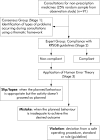Using human error theory to explore the supply of non-prescription medicines from community pharmacies
- PMID: 16885248
- PMCID: PMC2564009
- DOI: 10.1136/qshc.2005.014035
Using human error theory to explore the supply of non-prescription medicines from community pharmacies
Abstract
Background: The importance of theory in underpinning interventions to promote effective professional practice is gaining recognition. The Medical Research Council framework for complex interventions has assisted in promoting awareness and adoption of theory into study design. Human error theory has previously been used by high risk industries but its relevance to healthcare settings and patient safety requires further investigation. This study used this theory as a framework to explore non-prescription medicine supply from community pharmacies. The relevance to other healthcare settings and behaviours is discussed.
Method: A 25% random sample was made of 364 observed consultations for non-prescription medicines. Each of the 91 consultations was assessed by two groups: a consensus group (stage 1) to identify common problems with the consultation process, and an expert group (stages 2 and 3) to apply human error theory to these consultations. Paired assessors (most of whom were pharmacists) categorised the perceived problems occurring in each consultation (stage 1). During stage 2 paired assessors from an expert group (comprising patient safety experts, community pharmacists and psychologists) considered whether each consultation was compliant with professional guidelines for the supply of pharmacy medicines. Each non-compliant consultation identified during stage 2 was then categorised as a slip/lapse, mistake, or violation using human error theory (stage 3).
Results: During stage 1 most consultations (n = 75, 83%) were deemed deficient in information exchange. At stage 2, paired assessors varied in attributing non-compliance to specific error types. Where agreement was achieved, the error type most often selected was "violation" (n = 27, 51.9%, stage 3). Consultations involving product requests were less likely to be guideline compliant than symptom presentations (OR 0.30, 95% CI 0.10 to 0.95, p = 0.05).
Conclusions: The large proportion of consultations classified as violations suggests that either pharmacy staff are unaware of professional guidelines and thus do not follow them (therefore these acts would not be violations), or that they knowingly violate the guidelines due to reasons that need further research. The methods presented here could be used in other healthcare settings to explore healthcare professional behaviour and to develop strategies to promote patient safety and effective professional practice.
Conflict of interest statement
Competing interests: none declared.
References
-
- Institute of Medicine To err is human. Building a safer health system. Washington: National Academy Press, 1999
-
- Department of Health Organisation with a memory. London: Department of Health, 2000
-
- Royal Pharmaceutical Society of Great Britain Medicines, ethics and practice. Report No 29. London: RPSGB, 2005
-
- Sinclair H K, Bond C, Hannaford P. Over‐the‐counter ibuprofen: how and why is it used? Int J Pharm Pract 20008121–127.
Publication types
MeSH terms
Substances
LinkOut - more resources
Full Text Sources
Medical

